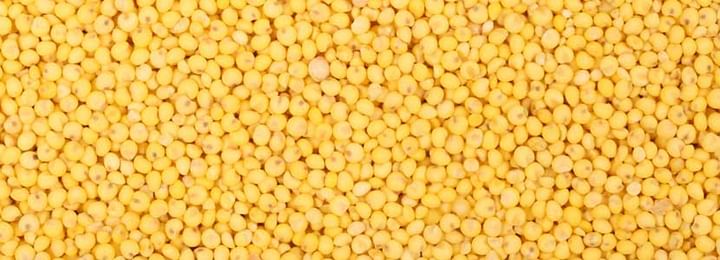Millet Health Benefits, Nutrition Value and Side Effects
Last Updated: Aug 20, 2020
Get Amazing health benefits of millets. Add this healthy cereal grain helps in coronary artery disorder, weight loss, colon cancer. Millets help in high blood pressure, preventing Celiac disease, diabetes problems, a good source of antioxidants, helps in slowing down muscle degradation, aids in sleep helps in relieving menstrual cramps, aids breast milk production, improves skin elasticity.
What is Millet?
Millets are a group of highly variable small-seeded grasses, widely grown around the world as cereal crops or grains for human food and as fodder. In India, millets have been mentioned in some of the oldest Yajurveda texts, identifying foxtail millet (priyangava), Barnyard millet (aanava) and black finger millet (shyaamaka), thus indicating that millet consumption was very common, pre-dating to the Indian Bronze Age (4,500BC). Millets however lack the nutrients critically important for a person’s body.
Nutritional Value of Millet
Millet is counted on around the world to provide basic nutrition for many developing nations. Every 100 grams of millets contain 378 calories of energy, 4.2 grams of total fat out of which saturated fat is 0.7 grams, total carbohydrate content is 73 grams, dietary fibre is 8.5 grams, protein content is 11 grams, folate is 85 mcg, niacin is 4.720 mg, Pantothenic acid is 0.848 mg, Riboflavin is 0.290 mg, Thiamine is 0.421 mg, Vitamin B6 is 0.384 mg, Vitamin E 0.05 mg, Tocopherol alpha is 0.05 mg, Vitamin K is 0.9 mcg, Calcium is 1%, Iron content is 17%, Copper is 38%, Magnesium is 28%, Manganese is 82%, Phosphorus is 28%, Potassium is 4%, Selenium is 4%, Zinc is 11%.
Nutritional facts Per 100 Grams of Millet
Vitamins and Minerals in Millet
Health Benefits of Millet
Millet Good for Heart Patients
Consumption of millet in large amounts helps decrease triglyceride levels in the body. It thins the blood to prevent blood platelet clumping, thereby reducing the risk of sunstroke and coronary artery disorder.
Millet Helps in Weight Loss
Millets contain tryptophan, an amino acid that lowers appetite and helps in managing weight. It digests at a slower rate and keeps the stomach full for a longer period of time. Millets are high in fibre and satiate hunger quickly, preventing from overeating. People who want to lose weight should incorporate millets in at least one of their main meals. Different types of millet are available for weight loss such as foxtail millet, Kodo millet, finger millet, and pearl millet. You can make different types of food recipes using this millet without compromising with the taste.
Millet Reduces Risk of Colon Cancer
Foxtail Millet contains both fibers and phytonutrients, the combination of which is believed to reduce the risk of developing colon cancer. Lignan, a phytonutrient in millet, is converted into mammalian lignan in the intestine that protects from breast cancer. In fact, the consumption of millet can lower the risk of developing breast cancer by 50%.
Millet Decrease High Blood Pressure
Magnesium present in millet which relaxes the muscles that line the inside of the arterial wall, which helps to reduce blood pressure. Millet also reduces the severity of asthma and frequency of migraines.
Millets Prevents Celiac disease
Millet Controls Diabetes
The low glycemic index in millet slows down the digestion process and keeps the blood sugar level at a constant ratio. Millets increase insulin sensitivity for people suffering from diabetes and also helps to control the sugar levels for non-diabetics especially type 2 diabetes.
Millet - Good Source of Antioxidants
The high amount of antioxidants present in millets fights free radicals present in the body which slows down the ageing process.
Millet Helps in slowing down muscle degradation
Millets are high protein grains and contain lysine, an amino acid which slows down muscle degradation and helps to build leaner muscles.
Millet Aids in Sleep
Tryptophan in millet raises the serotonin level in the body which helps in reducing stress. A cup of millet porridge every night can help to get sound and peaceful sleep.
Millet Helps in relieving menstrual cramps
Because of its high level of magnesium, millet is a great food for women who suffer from unbearable pain and cramps during their menstrual cycle.
Millet Aids Breast Milk Production
Pregnant and lactating women are advised to consume Ragi in high amounts to increase the production of breast milk in their body. This enables the mother to feed the child for a longer period of time.
Millet Improves Skin Elasticity
Millet is rich in amino acids called L-lysine and L-proline. Millet help to create collagen in the body, a substance which gives structure to the skin’s tissue. Thus, eating millet fortifies the collagen level to improve skin’s elasticity and makes it less prone to wrinkles.
Uses of Millet
Millets are also used to prepare alcoholic beverages. Millets are traditionally important grains used in brewing millet beer in some cultures, for instance by the Tao people of Orchid Island and the Amis or Atayal of Taiwan. It is also the base ingredient for the distilled liquor rakshi in Nepal and the indigenous alcoholic drink of the Sherpa, Tamang, Rai and Limbu people, tongba, in eastern Nepal.
Millets are major food sources in arid and semiarid regions of the world, and feature in the traditional cuisine of many others. Millet porridge is a traditional food in Russian, German, and Chinese cuisines.
In addition to being used for seed, millet is also used as a grazing forage crop. Instead of letting the plant reach maturity it can be grazed by stock and is commonly used for sheep and cattle.
Side-Effects & Allergies of Millet
Millets are safe when consumed in a moderate amount. It has been consumed as staple food by millions of peoples in the past thousands of years. However, excessive consumption of millet might cause an adverse effect. Millets contain goitrogen, a substance that interferes with the production of thyroid hormones and inhibits iodine uptake and utilization by the thyroid gland. Deficiency of iodine is a significant health problem which leads to the development of enlarged thyroid gland, known as goitre. Goitre causes dry skin, anxiety, depression and slow thinking. In the Sudan region of Africa where millet is consumed as the primary source of energy, the occurrence of goitre was much greater than anywhere else in the world. Hence, people with thyroid problems need to restrict their consumption of millets.
Cultivation of Millet
Millet is one of the oldest crops known to mankind. Both the ancestor and the location of domestication of millet are unknown. It was believed that millet was cultivated during the Neolithic period (8000-2000 B.C.) in China where farmers plant the proso millet during the Second Chinese Dynasty. Nowadays, millet still plays an important role in the diet of northwest China. Millets used to be cultivated in western Europe but with the extensive growth of potatoes, millet production increasing decreased and almost disappeared by the beginning of 20th century.
According to the Food and Agriculture Organization of the United Nations, millet production ranks fifth in the world cereal production, following corn, wheat, barley and sorghum. The production of millet had increased from 27.6 million tons in 2000 to 31.6 million tons in 2010. It is widely cultivated in the Russia, Ukraine, Kazakhstan, U.S., Argentina, Australia, Eastern Europe and southern India. The major exporters of proso millet are U.S., Argentina and Australia. The major millet importers are Belgium, Germany and Netherlands.
Millets have long been used as traditional staple foods by a large proportion of the world’s poor as in Asia and Africa. Currently, it was consumed in northern China, India, Africa and southern Russia. About 80% of the global millet production is directed consumed as human food in forms of porridges, breads, cakes, snacks, steamed goods and beverage. Because of lack of gluten, millet flour is normally used to make flat bread. Proso millet is used as a basic ingredient to make distilled alcoholic drink in Shanxi Province of China. It is also used to make bread-beer in Balkans, Egypt, Sudan and Turkey.
References
- Amadou I, Gounga ME, Le GW. Millets: Nutritional composition, some health benefits and processing-A review. Emirates Journal of Food and Agriculture. 2013 May 1:501-8. [Cited 26 June 2019]. Available from:
- Saleh AS, Zhang Q, Chen J, Shen Q. Millet grains: nutritional quality, processing, and potential health benefits. Comprehensive reviews in food science and food safety. 2013 May;12(3):281-95. [Cited 07 August 2019]. Available from:
- Chandra D, Chandra S, Sharma AK. Review of Finger millet (Eleusine coracana (L.) Gaertn): a power house of health benefiting nutrients. Food Science and Human Wellness. 2016 Sep 1;5(3):149-55. [Cited 26 June 2019]. Available from:
Table of content
Ask a free question
Get FREE multiple opinions from Doctors



